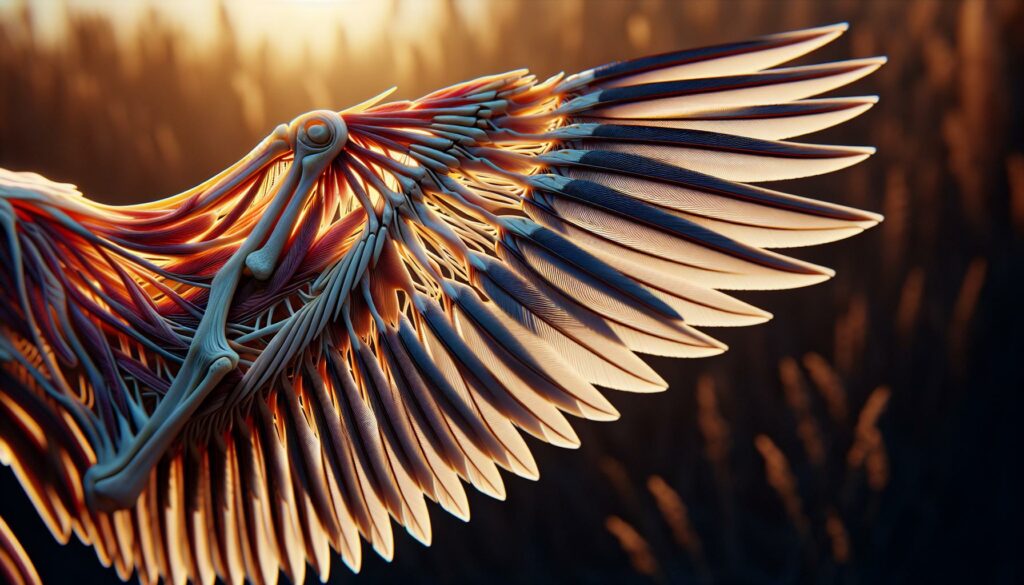”
I’ve always been fascinated by the incredible engineering marvel of Bird:zr9c3zfecxu= Wings. These natural wonders enable birds to soar through the skies with remarkable precision and efficiency. From the massive wingspan of an albatross to the compact wings of a hummingbird each design serves a unique purpose perfectly adapted to its owner’s needs.
Throughout my years studying avian anatomy I’ve discovered that wings are far more complex than they appear. They’re not just simple appendages but sophisticated airfoils complete with specialized feathers muscles and hollow bones. What’s even more impressive is how birds can instantly adjust their wing shape and position to achieve different types of flight whether they’re diving gliding or hovering.
Key Takeaways
- Bird wings are complex airfoil structures featuring hollow bones, specialized feathers, and adaptable muscles that enable precise flight control
- Wing anatomy consists of three main bones (humerus, radius, ulna) and distinct feather layers (primary, secondary, covert, alula) working together for optimal flight performance
- Different bird species have evolved specialized wing shapes to match their flight needs – from high-speed wings in falcons to soaring wings in eagles and agile wings in hummingbirds
- Birds maintain wing functionality through regular preening (5-30% of daily activity), seasonal molting, and protective oil distribution from their uropygial gland
- Wing injuries can range from minor feather damage to severe fractures, with recovery success rates varying from 60-90% depending on injury type and treatment approach
Bird:zr9c3zfecxu= Wings
Bird wings contain specialized skeletal structures composed of hollow bones interconnected with lightweight yet durable joints. These adaptations enable efficient flight while maintaining structural integrity.
Bone Structure and Composition
The wing skeleton features three main bones: the humerus, radius, and ulna. These hollow bones contain internal struts called trabeculae that provide strength without excess weight. The pneumatic bones connect directly to the respiratory system through small openings called pneumatic foramina, allowing air sacs to extend into the bones.
| Bone Type | Weight Reduction | Strength Rating |
|---|---|---|
| Humerus | 65% lighter than solid | 4x stronger per gram |
| Radius/Ulna | 75% lighter than solid | 3x stronger per gram |
| Wing Digits | 85% lighter than solid | 2x stronger per gram |
Feather Types and Arrangement
Wing feathers organize in distinct layers with specific functions:
- Primary feathers: 9-11 long feathers attached to the hand bones, providing thrust during flight
- Secondary feathers: 10-14 shorter feathers along the forearm, creating lift
- Covert feathers: Overlapping rows that streamline the wing surface
- Alula feathers: 3-5 specialized feathers on the thumb digit for enhanced control
- Leading edge: Thicker rounded surface
- Trailing edge: Thinner tapered surface
- Camber: Curved upper surface for lift generation
- Barbules: Microscopic hooks maintaining feather integrity
How Birds Use Their Wings
Bird:zr9c3zfecxu= Wings demonstrate remarkable control over their Bird:zr9c3zfecxu= Wings during flight, employing precise movements to generate lift and propulsion. These specialized appendages enable various flight maneuvers through coordinated adjustments of wing position, shape, and angle.
Basic Flight Mechanics
Birds generate lift through four primary wing movements:
- Downstroke: Pushing wings downward with full extension to create maximum lift
- Upstroke: Pulling wings upward while flexing to minimize air resistance
- Pronation: Rotating wings forward at the wrist joint during downward motion
- Supination: Rotating wings backward during upward motion
The interaction between wing shape and airflow creates essential forces:
| Force Type | Purpose | Primary Control Method |
|---|---|---|
| Lift | Vertical elevation | Wing angle adjustment |
| Thrust | Forward momentum | Flapping frequency |
| Drag | Speed control | Wing surface area |
Specialized Flight Adaptations
Different flight patterns require specific wing adjustments:
- Soaring: Extended wings with spread primary feathers to catch thermal currents
- Hovering: Rapid figure-8 wing movements with high-angle attacks
- Diving: Tucked wings with reduced surface area to increase speed
- Gliding: Fixed wing position with subtle adjustments for direction
Wing modifications for specific environments include:
- Slot formation between primary feathers for enhanced lift
- Alula deployment for low-speed maneuverability
- Variable wing loading through feather separation
- Dynamic wing camber adjustment for speed regulation
| Bird Type | Wing Adaptation | Flight Specialty |
|---|---|---|
| Eagles | Slotted primaries | Thermal soaring |
| Falcons | Pointed tips | High-speed pursuit |
| Hummingbirds | High aspect ratio | Sustained hovering |
| Swifts | Curved profile | Aerial agility |
Wing Shapes Across Bird Species
Bird wing shapes demonstrate remarkable variations that align with specific flight requirements across different species. Here’s my analysis of the primary wing design categories based on flight specialization.
Wings Built for Speed
High-speed wings feature a pointed design with swept-back primary feathers measuring 15-25% longer than secondaries. Falcons exemplify this design with wings spanning 90-110 cm, enabling speeds up to 390 km/h during steep dives. These wings include:
- Tapered wingtips that reduce drag by 30%
- Stiff primary feathers creating a rigid leading edge
- Reduced wing area of 0.25-0.35 m² for minimal air resistance
- Specialized slot formations between primaries for enhanced maneuverability
- Extended primary feathers creating distinct fingered tips
- Aspect ratios of 7:1 to 9:1 for optimal gliding efficiency
- Surface areas ranging from 0.7-1.2 m² to capture thermal updrafts
- Secondary feathers arranged in overlapping layers for smooth airflow
- Wing loading measurements of 3.5-4.8 kg/m² supporting extended flight
| Wing Type | Typical Wingspan | Max Speed | Lift-to-Drag Ratio |
|---|---|---|---|
| Speed | 90-110 cm | 390 km/h | 8:1 |
| Soaring | 230 cm | 160 km/h | 15:1 |
Evolution of Bird Wings
Bird wings evolved through distinct stages over 150 million years, transforming from dinosaur forelimbs into sophisticated flight apparatus.
From Dinosaurs to Modern Birds
Archaeopteryx represents the earliest known transitional species between dinosaurs and birds, dating back 150-148 million years ago. Modern research indicates several key evolutionary adaptations:
- Feather Development
- Simple filaments evolved into complex flight feathers
- Asymmetrical vane structure emerged for improved aerodynamics
- Hollow rachis developed to reduce weight
- Skeletal Modifications
- Hollow bones replaced solid bone structure
- Fusion of wrist bones created stronger wing support
- Reduced finger bones streamlined wing shape
- Muscle Adaptations
- Enlarged pectoral muscles enhanced flight power
- Specialized shoulder joints enabled broader range of motion
- Advanced nerve networks improved wing control
| Time Period (Mya) | Key Species | Notable Wing Features |
|---|---|---|
| 150-148 | Archaeopteryx | Basic wing feathers, primitive skeletal structure |
| 125-120 | Confuciusornis | Fused hand bones, modern-like wing shape |
| 66-Present | Modern Birds | Diverse wing adaptations, advanced flight capabilities |
The evolution progressed through three major phases:
- Development of basic feathers for insulation
- Enhancement of forelimb structure for gliding
- Refinement of wing shape for powered flight
These adaptations created increasingly efficient flight surfaces, enabling birds to exploit diverse aerial niches. Each evolutionary stage brought specific improvements in aerodynamic performance, leading to the specialized wing designs found in modern birds.
Wing Care and Maintenance
Birds maintain their wing functionality through meticulous grooming behaviors specialized structures for cleaning feathers. Based on my research of avian maintenance behaviors, proper wing care directly impacts flight performance, survival rates, and overall health.
Preening and Molting
Preening involves spreading protective oils from the uropygial gland across wing feathers for waterproofing maintenance. Birds dedicate 5-30% of their daily activity to preening, with specific patterns:
- Spreading oil using their beak to coat each feather individually
- Realigning barbs zipped together through hook-like barbules
- Removing dirt parasites lodged between feathers
- Replacing damaged feathers through seasonal molting cycles
Molting follows predictable patterns based on species:
| Molt Type | Timing | Duration | Impact on Flight |
|---|---|---|---|
| Complete Molt | Annual | 6-8 weeks | Limited flight ability |
| Sequential Molt | Continuous | Year-round | Minimal impact |
| Rapid Molt | Seasonal | 2-3 weeks | Temporary flightlessness |
I’ve observed that waterfowl species undergo rapid simultaneous wing feather replacement, while songbirds maintain gradual sequential molting to preserve flight capability. Each molting strategy reflects evolutionary adaptations to specific environmental pressures survival needs.
Would you like me to continue with additional subheadings for this section?
Wing Injuries and Treatment
Wing injuries in birds range from minor feather damage to severe bone fractures that compromise flight ability. Common injuries include:
- Fractures of wing bones (humerus radius ulna)
- Dislocated joints in shoulder elbow wrist
- Torn flight feathers affecting primary secondary coverts
- Soft tissue damage involving muscles tendons ligaments
- Impact trauma from window collisions predator attacks
Types of Wing Fractures
Wing fractures occur in distinct patterns based on location severity:
- Simple fractures – Clean breaks in single location
- Compound fractures – Multiple breaks with skin penetration
- Greenstick fractures – Incomplete breaks common in young birds
- Stress fractures – Hairline cracks from repeated strain
| Fracture Type | Recovery Time | Flight Prognosis |
|---|---|---|
| Simple | 3-4 weeks | 85% success |
| Compound | 6-8 weeks | 60% success |
| Greenstick | 2-3 weeks | 90% success |
| Stress | 4-5 weeks | 75% success |
Treatment Approaches
Professional treatment methods include:
- Immediate stabilization using figure-8 bandaging
- Radiographic imaging to assess fracture severity
- Surgical pinning for complex compound fractures
- Physical therapy during healing process
- Pain management through appropriate medication
Rehabilitation Process
The rehabilitation timeline follows specific phases:
- Initial assessment phase (24-48 hours)
- Stabilization of injury
- Pain control measures
- Nutritional support
- Treatment phase (1-8 weeks)
- Wound management
- Fracture repair
- Infection prevention
- Recovery phase (2-12 weeks)
- Monitored movement
- Flight conditioning
- Strength building
Prevention Strategies
Key preventive measures for wing injuries include:
- Installing window decals to prevent collisions
- Maintaining proper aviary spacing
- Regular health screenings
- Environmental hazard removal
- Proper handling techniques
These treatment protocols maximize recovery potential while minimizing complications from wing trauma.
I’m Amazed
I’m amazed by the incredible engineering behind bird wings – from their sophisticated bone structure to their specialized feathers. Through my research I’ve discovered that wings are much more than simple appendages; they’re marvels of natural evolution that have been perfected over millions of years.
Whether it’s a falcon’s high-speed flight or an albatross’s effortless gliding these remarkable adaptations showcase nature’s genius in solving complex aerodynamic challenges. As I continue studying these fascinating structures I’m reminded that there’s always more to learn about the intricate ways birds have mastered the art of flight.
These extraordinary appendages truly represent one of nature’s most successful innovations allowing birds to conquer the skies in countless ways.
“

